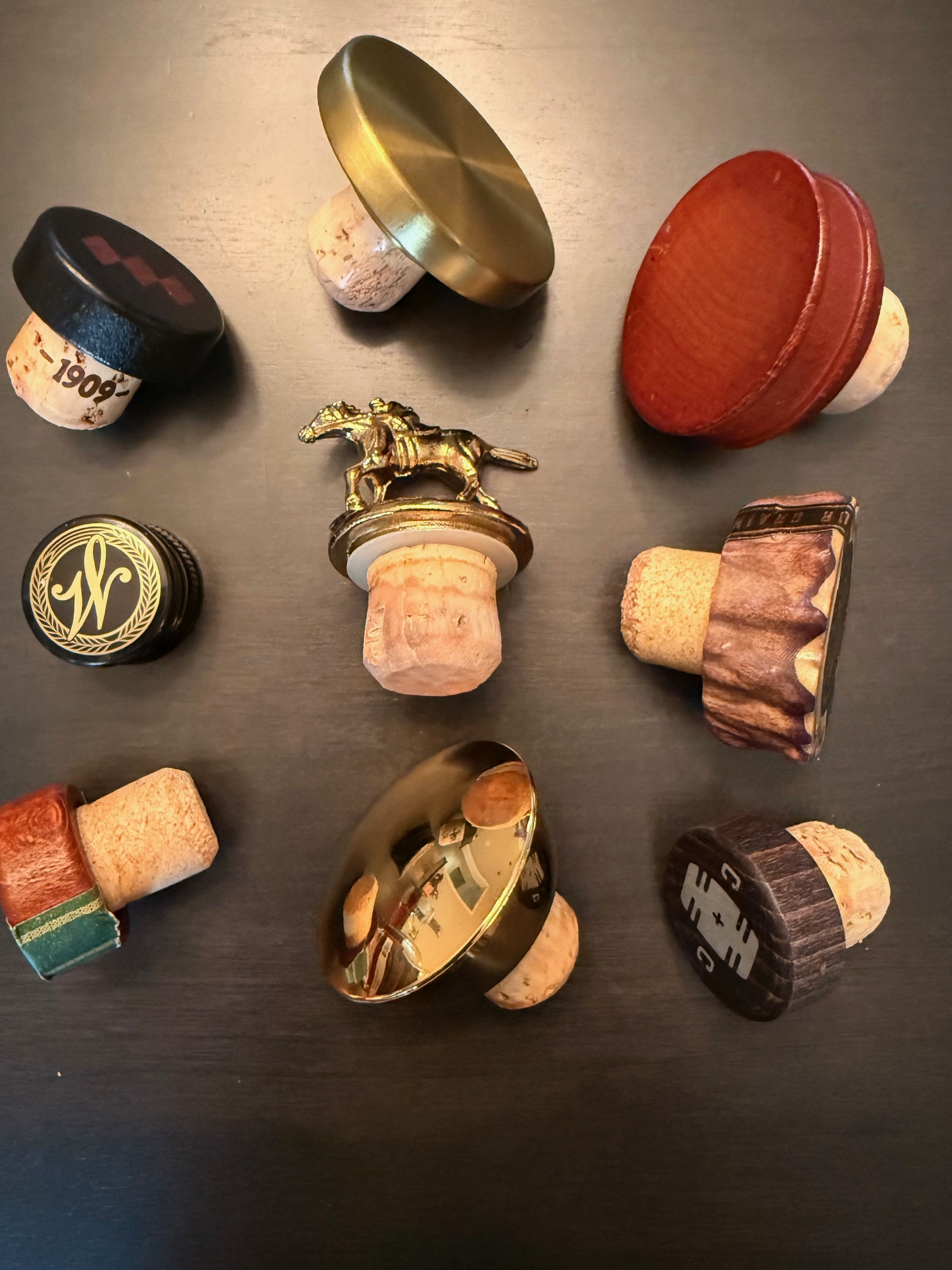Fun Facts About Whiskey Corks

There’s nothing like bringing home a new bottle of whiskey you’ve been excited to try. If you’re anything like me, your focus is on the pour, not the cork. But here’s the thing— every little detail counts when it comes to keeping those rich flavors intact. And a good cork does more than just seal the bottle, it plays a big role in preserving your whiskey’s quality. While corks might seem like a small, simple choice, there’s a lot of variety out there. Let’s break it down and explore the types of whiskey corks, why they’re used, and their pros and cons.
Natural Cork
Natural corks are typically used in higher-end whiskeys. Natural cork is made from the bark of cork oak trees, so it’s a natural and sustainable material. It is breathable, allowing for just a tiny bit of oxygen exchange. This can lead to subtle changes in the whiskey’s flavor over time.
Natural corks usually look, well, natural. You’ll see the unique grain and texture of cork bark, and they might feel slightly softer when you press on them. Many high-end whiskey brands value the classic aesthetic and authenticity that natural corks provide, as they align well with the craftsmanship and heritage often associated with these products. If you love the old-school whiskey vibe, bottles with natural cork are the way to go. It offers that classic feel and can even contribute to subtle flavor aging in the bottle. It’s the classic choice and has been the go-to choice for ages for good reason.
- Pros:
- Sustainable and eco-friendly
- Creates a tight seal
- Adds that authentic whiskey experience
- Cons:
- Can sometimes have imperfections that lead to issues like a musty, off flavor (blame a compound called TCA for that).
- Needs proper storage to avoid mold or mildew.
Agglomerated Cork
Agglomerated corks are typically found in less expensive bottles of whiskey. Made from cork granules that are compressed and bound together into a solid form, this is a budget-friendly option for distilleries. Since they are made from compressed cork granules, they are more affordable to produce than natural corks while still offering a reliable seal. This cost-effectiveness makes them a popular choice for distillers looking to balance quality with budget considerations.
These look smoother and more uniform than natural corks, almost like particle board. If the surface looks pressed together or overly consistent, it’s probably agglomerated. While they may lack some of the nuanced benefits of natural cork—such as subtle oxygen exchange for flavor development—they are a great option for bottles that are meant to be enjoyed sooner rather than aged for extended periods.
- Pros:
- Affordable and reliable
- Less prone to quality issues like TCA
- Durable and strong
- Cons:
- Less breathable than natural cork, so it doesn’t allow for as much flavor development over time.
- Slightly less eco-friendly due to the production process.
Synthetic Cork
Synthetic corks are used across a range of price levels in the whiskey market, but they are particularly common in less expensive and mid-range bottles. Synthetic corks are a more modern option and are made from—you guessed it—synthetic materials. They’re built to avoid the pitfalls of natural cork while keeping things functional and consistent. Their cost-effectiveness and durability make them an attractive option for distillers aiming to keep production costs down while ensuring a reliable seal.
That said, synthetic corks are not exclusive to budget-friendly bottles. Some premium whiskey brands also use them, especially when the goal is to eliminate risks associated with natural cork, like TCA (which can cause off flavors) or cork deterioration. Synthetic corks are consistent, mold-resistant, and often made from recyclable materials, making them practical for long-term storage. They often have a shiny or plasticky appearance, typically firmer to the touch, and don’t have the earthy scent or feel of natural cork. Synthetic corks are tough to beat if you’re worried about things like mold or breakage. They’re also a safe bet for bottles you plan to open and close frequently.
- Pros:
- Reliable and consistent quality
- Mold-resistant and TCA-free
- Often made from recycled materials, so it can be eco-friendly
- Cons:
- Doesn’t have the same authentic feel as natural cork
- Less breathable, so it won’t allow for that subtle aging some whiskey lovers enjoy
Glass Stoppers
Glass stoppers are typically found in higher-end and premium-priced whiskeys. These stoppers add a touch of elegance and sophistication to the bottle, making them a popular choice for limited editions, special releases, or whiskeys aimed at collectors.
If you’ve ever seen a bottle with a glass stopper, you know it just screams sophistication. The visual appeal of a glass stopper complements the premium branding and enhances the overall unboxing and display experience. Glass stoppers are all about style, but they’re functional, too. They’re clear (or sometimes frosted) glass and often come with a silicone or rubber ring around the edge to create a seal. The reusable nature of glass stoppers makes them attractive to consumers who value both aesthetics and functionality.
- Pros:
- Adds a touch of elegance
- Reusable and durable
- Easy to sanitize
- Cons:
- Can be heavy and prone to breaking
- Doesn’t always seal as tightly as cork, so air might sneak in
Should I Choose My Bottle Based On The Cork?
I don’t recommend choosing your bottle based on the cork. There are plenty of great mid-range priced bottles. What the cork would determine for me is how I store and drink my whiskey.
Natural and glass corks are usually in more expensive bottles and these corks allow the bottle to continue to age. Frequent opening and closing can cause natural cork to dry out or allow mold to form. But you probably won’t be opening your more expensive bottles as frequently, which limits air exposure and helps maintain the integrity of the seal.
You should always store these bottles upright to prevent prolonged contact between the cork and alcohol. Whiskey’s high alcohol content can degrade natural cork over time, leading to crumbling or leaks. Similarly, glass stoppers should remain upright to minimize the risk of air leakage or moisture buildup around the seal.
Agglomerated and synthetic corks are usually going to be in bottles that I reach for frequently because I’m not collecting them and am often using them in cocktails, etc. There are always exceptions, and one is Buffalo Trace. It’s an excellent bourbon in the mid-price range, is as good neat as it is in an Old Fashioned, and has a classic natural cork. But these bottles go too fast to worry about issues with the cork.
Ideas For Whiskey Corks
Once you’ve polished off a few bottles, don’t just toss those corks! Some whiskey fans love collecting them as a way to remember their favorite bottles. Here are a few ideas of ways to use them:
- Display Them: Create a shadowbox or a glass jar filled with corks for a cool visual reminder of your favorite bottles or occasions.
- DIY Projects: Turn your corks into coasters or a framed corkboard.
- Keep It Simple: Write the bottle name and date on the cork as a mini memento.
Collecting whiskey corks is a fun way to tell the story of all the great bottles you’ve enjoyed.
Cheers to that!

Leave a Reply
Become an insider and receive weekly advice, tips, and insight on all things whiskey
.
Weekly tips, reviews and recommendations to help you enjoy whiskey life to the fullest.
JOIN THE LIST
Sippin' With Jordan Davis
sippin' with the stars
Million Dollar Cowboy Bar WY
old fashioned aF
5 Steps To Sip and Savor Whiskey
whiskey 101
COMMENTS